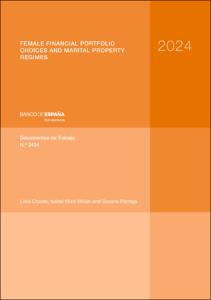Female financial portfolio choices and marital property regimes
Autor
Fecha de publicación
10-oct-2024
Descripción física
50 p.
Resumen
Este documento estudia la relación entre las decisiones de cartera de inversión de las parejas casadas y su régimen matrimonial. Usando datos de encuesta en hogares muy detallados, explotamos la variación regional de las leyes de propiedad matrimonial por defecto en España para estimar los efectos causales del régimen matrimonial sobre la inversión financiera de los hogares. Los resultados sugieren que las parejas casadas en separación de bienes invierten en carteras con mayor riesgo en comparación a las parejas en gananciales en las que las mujeres son las responsables de las decisiones financieras del hogar. Para entender estas diferencias en las estrategias de inversión entre hogares, desarrollamos un modelo en el que las parejas deciden cuánto ahorrar y en qué activos hacerlo mientras están sujetas al riesgo del divorcio, pero difieren en su régimen matrimonial y en el género del cónyuge encargado de tomar las decisiones financieras. Un modelo donde los costes de disolución del régimen de gananciales sean suficientemente elevados para las mujeres replicaría los resultados empíricos. Un coste elevado reduce la renta disponible futura de los esposos en caso de divorcio, lo que incentiva la elección de carteras de inversión más seguras en comparación con las parejas en separación de bienes que no se enfrentan a ningún coste. Mayores transferencias de ahorro de las parejas en caso de divorcio atenúan este mecanismo y menores niveles de renta lo refuerzan.
This paper studies the relationship between married couples’ portfolio choices and property division rules. Using rich household survey data, we exploit the regional variation in marital laws across Spain to estimate the causal effects of property division rules on household financial investment. We find that separate-property couples hold riskier financial portfolios than community-property ones when wives take charge of the household finances. To understand this gap in risky asset holdings, we develop a financial portfolio choice model where couples are subject to divorce risk but differ in their property division regimes and the gender of the spouse making the financial decisions. A model in which the costs of dissolving a community property regime in the event of divorce are sufficiently high for women is likely to replicate the empirical estimates. High dissolution costs of marital assets upon divorce reduce spouses’ future disposable income in the event of divorce, encouraging precautionary savings in the form of safe assets during marriage as compared with their separate-property counterparts who bear no cost. Greater transfers of savings between couples in divorce attenuate this mechanism, while lower income levels reinforce it.
This paper studies the relationship between married couples’ portfolio choices and property division rules. Using rich household survey data, we exploit the regional variation in marital laws across Spain to estimate the causal effects of property division rules on household financial investment. We find that separate-property couples hold riskier financial portfolios than community-property ones when wives take charge of the household finances. To understand this gap in risky asset holdings, we develop a financial portfolio choice model where couples are subject to divorce risk but differ in their property division regimes and the gender of the spouse making the financial decisions. A model in which the costs of dissolving a community property regime in the event of divorce are sufficiently high for women is likely to replicate the empirical estimates. High dissolution costs of marital assets upon divorce reduce spouses’ future disposable income in the event of divorce, encouraging precautionary savings in the form of safe assets during marriage as compared with their separate-property counterparts who bear no cost. Greater transfers of savings between couples in divorce attenuate this mechanism, while lower income levels reinforce it.
Publicado en
Documentos de Trabajo / Banco de España, 2434
Materias
Finanzas personales; Decisiones de inversión; Matrimonio; Género; Derecho de familia; Personal finance; Portfolio choice; Marriage; Gender; Family law; Selección de carteras; Economía del consumo y del ahorro; España
Aparece en las colecciones:












